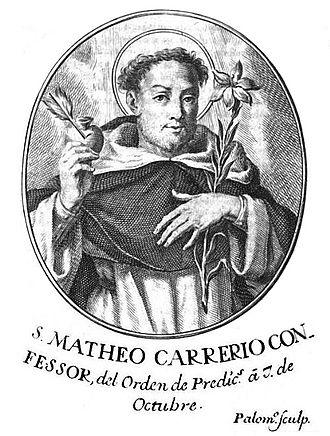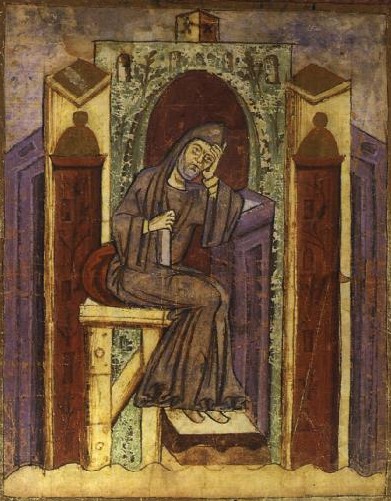‘Blessed’ Sanctity: Tales of Three Holy Lives on the Highway to Sainthood
The goodness of Matthew Carrieri, Notker the Stammerer and Margaret of Castello.

Many saints have been given the distinction of “Blessed” on their path to canonization, and some people see it as a mere formality that anyone who is beatified will be canonized in relatively short order. For Mother Teresa — who was beatified on Oct. 19, 2003, and canonized on Sept. 4, 2016 — the wait amounted to just under 13 years. However, some of the beatified have remained in their blessed predicament for several centuries without being canonized, including three notables.
Blessed Matthew Carrieri was born around 1420 in Mantua, Italy. He became a Dominican priest and is most famous for an incident that took place when he was sailing along the coast of Tuscany and his ship crossed paths with a pirate ship.

Overtaken by the pirates, it appeared that Father Carrieri and the other passengers were “doomed to perpetual slavery,” but Father Carrieri appealed to the pirate’s captain with such conviction that he and two fellow priests were liberated, according to the 1845 work Ages of Faith (Vol. 2).
Though most would be glad to leave with their freedom, Father Carrieri saw that a mother and her daughter remained in captivity. He asked the pirate-captain to release the pair. When this entreaty was met with refusal, Father Carrieri asked to be taken back into captivity in exchange for the release of the woman and her daughter. The hardened pirate was so stunned by Father Carrieri’s altruism that he let all captives go free.
Away from danger, at a Dominican monastery about 40 miles from Milan, Father Carrieri taught catechism to another beatus, the Dominican tertiary Blessed Stephanie of Quinzanis, a stigmatic who could “discuss mystical theology at the most profound level” despite having no formal education in theory, according to the Dominican website http://WillingShepherds.org/. She received her stigmata when she was in her early teens, shortly after her spiritual teacher, Father Carrieri, died in 1470.
Though Father Carrieri was beatified just 12 years later, in 1482, more than five centuries have passed without his graduation to sainthood.
Blessed Notker the Stammerer, aka Notcerus Balbulus, was born into an aristocratic Swiss family in A.D. 840. As a child, he studied at the Benedictine Abbey of St. Gall, where he remained and eventually became a librarian and teacher.

However impeded he was at speaking, he certainly could write and is commonly regarded as the “Monk of St. Gall” who authored a book of stories, De Carolo Magno, about Emperor Charlemagne that “won immediate and lasting popularity in the Middle Ages” and is “chiefly responsible for the emergence of the legendary figure of Charlemagne in medieval literature,” according to the New Catholic Encyclopedia (2nd edition).
He also authored a series of mnemonic poems — known as sequences — to be sung during Mass. His surviving correspondence reveals a witty man capable of self-effacement who describes himself as being “more sluggish than a tortoise,” as told in Lewis Thorpe’s introduction to the 1967 edition of the Two Lives of Charlemagne. The stammering Notker died in A.D. 912 and was beatified six centuries later, in 1512.
Blessed Margaret of Castello was born near Florence, Italy, in 1287. Though she entered a family of high rank, her life was severely compromised, as she suffered from blindness, dwarfism and a misshapen spine. “Ashamed” and “embarrassed” by their handicapped child, her family “walled [her] up in a room beside a chapel” within their ancestral castle, as told by the Blessed Margaret of Castello Guild on its website, LittleMargaret.org.
When she was a young woman, her parents brought her to a shrine at Città di Castello, where the deformed and sick reportedly had been cured. Upon seeing that no miraculous improvement in her condition would take place, her parents abandoned her.
The situation looked bleak, but people in the community helped her to survive, and she eventually succeeded in joining the Dominican Third Order of Castello. Known for a cheerful disposition, she did what she could to assist the sick and the dying up until her own death, at age 33 in 1320. She was beatified in 1609.
In recent time, the formerly crippled and unwanted daughter has been adopted as a patron for pro-life groups and for those who have, or are expecting, a child with disabilities. Today, there is a Blessed Margaret of Castello Shrine at St. Patrick’s Church in Columbus, Ohio, and the Blessed Margaret Guild she inspired works to benefit marginalized people and seeks to promote her cause for canonization.
Dominican Father Michael Dosch is a pastor at St. Patrick’s Church and serves as director of the Blessed Margaret Guild. He feels that Blesseds serve the “same [importance] as the saints! ... The beati (or blesseds) are all declared to be in heaven interceding for us. There is a formal process that takes time and, therefore, financial resources, to keep following the steps leading up to canonization to sainthood. There is also the requirement for another approved miracle” (though this may be waived, as was the case with St. John XXIII).
Father Dosch added that the beati are “part of that beautiful array of the Church triumphant. … They are an example, like all the saints. It is not very different. In some ways, it can be viewed as a hierarchical ranking of the community of saints, from our perspective. The Blesseds intercede for us and are examples — but there is always that potency that God and the Church will raise them to higher honors for the purpose of the holy example of their lives.”
He expects Blessed Margaret will see the higher honor of canonization in the coming decades. “Because she is patroness of the unwanted, it stands to reason that God would raise her to sainthood because of the scourge of abortion. Canonization is sometimes chosen in a timely way, either intentionally by the Church or simply by God’s providence,” he said.
“The acts of God in the world of humanity is not always clearly known, but Blessed Margaret’s canonization will occur at the right time and in the right manner,” added Dominican John Keenan, who serves as councilor for the Blessed Margaret of Castello Chapter of the Idaho Lay Dominicans.
This chapter, which was established in the late-1990s, has commissioned a four-foot statue of Blessed Margaret and prays for her canonization but does not formally promote the cause.
Keenan also agrees that her patronage by pro-life groups could increase her chances for canonization, and his chapter “expects that Blessed Margaret will be canonized in this generation or the next, as her story is very compelling and very attractive.”
It’s a canonization that has been 400-plus years in the making. The road from beatification to sainthood is not necessarily a highway. And even the noblest of souls can remain “stuck at blessed.”
Ray Cavanaugh writes from Boston.
This is a longer version of the print column.
Images via Wikipedia
- Keywords:
- christian witness
- holiness
- saints
- saints and blesseds

















